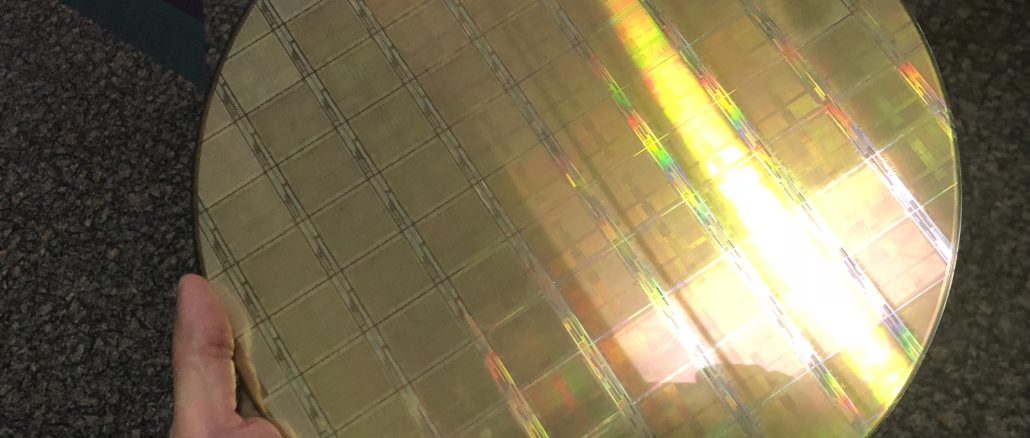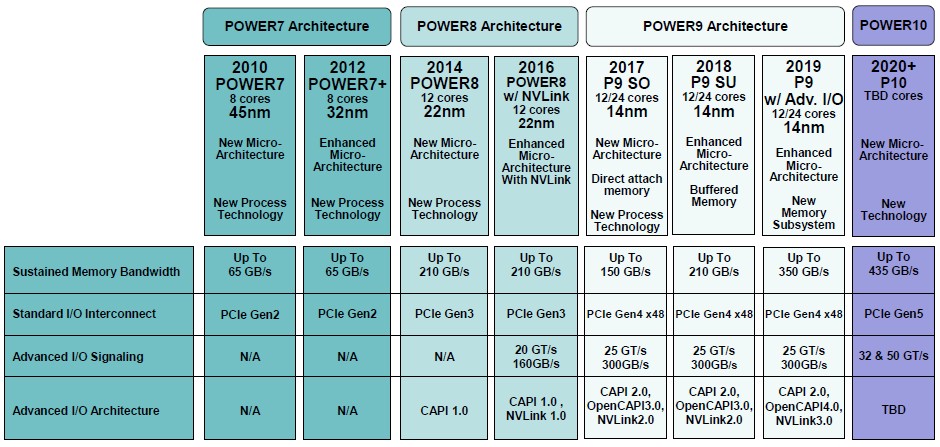
If you want to build a successful hardware ecosystem around a chip architecture that has recently been open sourced, as the Power chip instruction set was last August, then it probably makes a lot of sense to put someone at the helm of the project who has deep and broad experience participating in the open source software ecosystem. And that, with the appointment of James Kulina as executive director, is what the OpenPower Foundation has just done.
The OpenPower Consortium was formed back in August 2013 by IBM, Google, Mellanox Technologies, Nvidia (which now owns Mellanox), and Tyan (a maker of motherboards and servers). The effort was spearheaded by Brad McCredie, who was chief technology officer for Big Blue’s Systems group at the time, who managed the development of several generations of Power chips for servers, and who is now in charge of GPU platforms at AMD since July last year. When the consortium was converted into a more formal OpenPower Foundation a year later, Gordon MacKean, who was then senior director of server and storage systems design at Google, was named the first chairman of the foundation, a job he held for a few years. In November 2017, Hugh Blemings, who was in charge of the OzLabs team that ported the Linux kernel to IBM’s Power4 chip more than a decade ago and who was peripherally involved with the “Barreleye” Power9 server while at Rackspace Hosting, was named executive director of the OpenPower Foundation and helped get the organization under the Linux Foundation umbrella and also to get the Power instruction set architecture, or ISA, opened up.
Effective today, Kulina, is the new executive director of the OpenPower Foundation, and his appointment follows the trend of gradually moving from a systems-centric view from the people at the top to one where people are more familiar with the open source software movement and how to build ecosystems. We had a chat about the OpenPower effort and what plans Kulina has to shape what the foundation does and to make Power more broadly implemented than it is currently today.
Timothy Prickett Morgan: Tell us a little about yourself before we get into the nitty gritty about the Power ecosystem.
James Kulina: I have been in the open source ecosystem quite a while. My previous startup, which I co-founded, was called Hyper.SH, and we created what is now called Kata Containers, which is a top level project within OpenStack that we created in collaboration with Intel. Kata Containers retooled the KVM hypervisor for container workloads so they can use utilize hardware enforced virtualization for containers, using it as an isolation boundary. And we did that for a number of years, and popularized the idea of hypervisor-based containers. And so you saw Microsoft come out with Hyper-V containers and you saw Amazon Web Services come out with Firecracker – and there have been a number of others. We actually sold our startup off last year to Ant Financial, which is part of Alibaba, and they’re rolling that out internally in a couple of their datacenters and in a number of other initiatives they have.

Before that, I was at Red Hat doing product management within the OpenStack group, and mostly on the DevOps tooling and enablement around OpenStack making it easier to consume, use, and deploy. I got to Red Hat through another acquisition of startup called eNovance, where I was the product leader and where we did professional services around very large OpenStack deployments for governments and telcos. And before that I was actually at AT&T, working within its own Foundry service, which is a kind of incubator division that takes new technologies and figures out how to deploy them within AT&T divisions and business units. With that job, I was helping AT&T build out the first OpenStack private cloud and figuring out how to utilize that for telco workloads.
So I’ve had a lot of experience with open source software, and I am obviously an open source advocate and I believe in the ecosystem and the shared collaboration and the innovation that it drives. And, just for the record, before all of that, early in my career, I was actually doing system-level hardware design for a small company in the telco area called Patton Electronics. Over the years, I had seen what had happened in the open source software ecosystem and then I saw these new initiatives around hardware, such RISC-V and others, and I always kept an eye on OpenPower. I thought it was excellent architecture.
TPM: And it is an excellent architecture. Correct.
James Kulina: When IBM open sourced the Power ISA last year – which I personally believe they should have done maybe five or ten years ago. . . .
TPM: Ten years ago would have been good, I agree. . . .
James Kulina: They finally did it, and I think the timing is perfect for this ground up work in the open source hardware ecosystem and taking the learnings from open source software and building upon that with hardware. And I think we have a bunch of assets within our ecosystem and now it’s just about aligning it, about streamlining it, about figuring out how to best serve the community, to make it grow and to enable people to consume it and start building chips and building systems. So it’s not just on the shoulders of IBM.
TPM: Let’s take a look at that for a minute then. Shortly after OpenPower was started, Suzhou PowerCore in China said that it was doing its own modifications of the Power8 chip, I think as much to port it to the Semiconductor Manufacturing International Corp (SMIC) foundries in China as anything else. As far as I know, Suzhou PowerCore, which had made other PowerPC processors under license from IBM, finished its project, but we haven’t heard of anything since then. I don’t know if anybody else is doing a Power8 or Power9 design aside from IBM. So what what’s the status of companies licensing the core Power chip technology and creating variants of them? And how important is that?
James Kulina: It’s very important. In terms of adopting the technology, there’s a number of companies in process. A lot of interest right now is within creating domestic chips. So China is a big market for this. And there’s a number of companies looking at taking Power and seeing what they can potentially do with it. I don’t have the exact stages of where they are all at, but there is definitely interest in Power, especially in light of RISC-V. I think RISC-V has gotten people thinking about open source hardware and processor design in the open. RISC-V is in its very early days, whereas you look at Power, it is the opposite. It’s a very stable, capable platform, and now that it’s fully open source, and it’s royalty free and you can get those patents behind you and not have to worry about it. And this means people can actually try out both and look at where Power is targeted and where RISC-V is targeted.
TPM: RISC-V has yet to field a decent server chip design, but I remain hopeful. What kind of use cases are those domestic Power chips focused on? Are they trying to do a server processor, or is it embedded stuff? Those of us on the outside don’t have any visibility into this at all. As far as I know, nobody’s interested. Is it telco or a hyperscaler or a service provider of some kind, or a system builder? There is a lot of secrecy in this business among the largest enterprises who can do – and sometimes actually do – interesting things.
James Kulina: There’s a lot of that. When they adopt technology internally, there’s gag orders.
TPM: That is always annoying as all hell for us. But anyway. You and I both know that the Power architecture used to own the embedded market before Arm did and X86 also pushed down into there. Power was the anointed heir to the Motorola 68K, which in fact did own the embedded market as the PowerPC consortium was formed and Arm had not yet begun its rise in tablets and smartphones and then on to embedded devices. My point is, there are a lot of places that Power can go back into.
James Kulina: I think the main focus of OpenPower chip efforts are around machine learning and AI workloads, and particularly around cloud-based workloads. This doesn’t limit them from going into the embedded space. There are companies that are looking at embedded with Power. But IBM won’t do that, and has gotten out of that business. And so most of the activity is where they need the extra compute and the extra flexibility of customizing that for whatever their application needs are. And it seems to be in that AI and ML space where they can really make a difference by having that customization.
TPM: What about databases? My inkling with Google, which built the “Zaius” Power9 servers and deployed them, was that it was a particularly good database engine as well as a particularly good search engine motor. They kind of hinted that without ever committing to saying anything specific. But that’s another obvious place where Power chips could be useful because of the higher memory bandwidth and I/O bandwidth they have.
James Kulina: It is an obvious place. But I don’t really have any information on that.
TPM: That’s fair. It is your first day on the job.
Here’s an idea want to toss out there. If I was deadly serious about OpenPower and I was Big Blue, I would say Power10 is the last chip that IBM is going to design alone. Throw it down, and solicit community support in defining and designing Power11. That way, it’s not just IBM’s chip, it’s their chip, too. Give people a stake in it. They can maybe create a four-core version with a different balance of I/O and memory, whatever.
James Kulina: So I think what you’re getting at is how do you build an ecosystem.
TPM: Well, you can jump start it. Or you can you can wait for it to build by itself. But this is not one where you can wait. You have to you have to get a move on.
James Kulina: So one of the things that I would love to see within the OpenPower Foundation is reference cores. And that’s probably going to have to come from IBM to seed the market so that people have a starting point that is not just a whiteboard and a marker. That’s something that we will talk to IBM about. And hopefully they will be receptive and actually seed that market, considering that they have a stake in it. IBM definitely wants multiple companies out there building on Power at this point.
There is an interesting whitepaper from Arm on what is the value of the Arm ecosystem in designing a new SoC. And it boiled down to a 50 percent reduction in the cost of designing a middle-complexity chip.
TPM: Arm has finally gotten its server act together with Neoverse and they’re actually trying to help people design a better server chip rather than trying to sell component designs and hope they buy most of them and make the rest themselves. It’s a radically different thing.
It’s not a coincidence, I think, that Ampere Computing threw most of that Applied Micro IP on the floor and took Neoverse and modified it slightly for the Altra chips it has announced. And by doing that, it will get chips into the field a lot faster and end up with a better chip, too. It makes sense to do the same kind of thing with OpenPower. That’s your job, and IBM has to enable you to do that.
James Kulina: The focus is making OpenPower one of the easiest platforms to build. How do we come together to create and how do we help and enable people to actually create new chips faster and get it customized for your needs. How do we create the tooling to enable that? And we’ll be pulling and pinging companies that can actually participate and actually help in that initiative. IBM obviously being one of them, probably a major one in terms of helping out as well.
TPM: What else do you need to open source to make this OpenPower ecosystem better?
James Kulina: The reference cores is a base component that needs to be out there, and potentially reference designs based on that reference core. You need access to really advanced EDA tooling – hopefully open source software.
You need to create a pipeline to go from an idea to a chip, know what you are going to encounter in terms of roadblocks. As a foundation, we need to start thinking three to four steps ahead and start taking those roadblocks away. So I think 2020, to be honest, is going to be a rebuilding year for the foundation. Because we’re under the Linux Foundation, we have access now to the greatest and the best open source projects out there and to the learnings that they have on how to build lasting ecosystems and fast-moving ecosystems.
TPM: What’s your goal for all the other pieces that go into making a chip? The reference core is a lot of it, but if you look at Power8 or Power9 chips, they’ve got very advanced SerDes and NUMA interconnects and all kinds of I/O and memory controllers.
When you go to Arm, everybody their PHYs and memory controllers from Cadence. I can imagine someone could get a memory controller from Cadence as well and drop it next to a Power core and not have something that looks a lot like Power9 or Power10 but is still interesting. Or you could license these components from IBM. Where are designers going to get their Ethernet controllers from? No one’s going to design that stuff from scratch. That’s not that the value – it is in how you put it together, the crossbar and all that stuff that you differentiate on.
James Kulina: What you’re really getting at is this movement towards chiplets.
TPM: Well, there’s that too.
James Kulina: By that, I do not mean it literally has to be packaged as chiplets. But the idea is the same as where I came from in the container space, and it is a model where they break a system apart into components. You reduce the complexity, breaking the problem down into smaller pieces that are easier to solve independently. Then you make those things commodities, and now it’s all about how you do the interfacing, right? I mean, with the elimination of Moore’s Law and the rising costs of building chips and verifying chips and all these other things, I think you’re going to see a lot more concerted effort in how to make it easier to consume or align the IP with the process of invention. You don’t have to go take everything to 7 nanometers. You can take this to 7 nanometers because you need the performance, and in this other component that’s going to be at 28 nanometers. This one is in 65 nanometers. Right. And you know, it’s then you standardize the I/O and the interfacing, the connectivity between everything.
I think you’re going to see people who don’t have the knowledge necessary to build a really advanced chip from scratch still be able to enter and rely on what people have done before in building this new IP that’s open source. And, you know, my vision and my goals are around creating a marketplace for this.
Wouldn’t it be fantastic if it was like a Docker hub with containers? You go there and get a list: I need this, I need that. And it’s all standardized interfaces. And you have more transparency in how to put these things together and how these things are going to cost and all that complexity around it.
TPM: If you are going to pay more for a chip anyway, which is the given here at this point – transistor costs are going to go up, there’s no getting out of that anymore – then you might as well get exactly and precisely the chip you need and not get anything you don’t need. And then I don’t know what the price difference is for mass customization of chips, but at some point, it’s going to make a lot of sense for – pick a number – thousands of companies on Earth. And if enough of them have similar requirements, then they can be millions of companies sharing many – dozens or hundreds – of different designs. The SKU stack could get crazy, but it would be a lot of fun.
James Kulina: This is where it’s vital to, right from the start, have the verification and certification path. You need to make sure that you don’t break ISA, that it’s all standardized and it all works regardless of what changes have been made. If you’ve done something wrong, then it’s not going to be supported. And the verification and certification that happens with software should also happen for hardware. You want to de-risk a new platform and the entire process.
TPM: Last question here. How will this happen? Will we see one or two alternate Power chips eventually come out? Will we never see them because they are used by militaries and governments and hyperscalers, or will there be ten variations and we see them publicly? How do we gauge success here? If IBM is the only visible company making a Power chip, then OpenPower is not going to be perceived as being successful.
James Kulina: Well, obviously, one of the key performance indicator metrics will be around multiple silicon vendors. The goal is obviously to get other companies building advanced chips on the Power architecture other than IBM. And I think the OpenPower Foundation’s role in that is to de-risk it so that they can take that opportunity because the Power architecture is an excellent, stable architecture. And then hopefully they will share some of their learnings and some of their IP with the community to allow others to build on their work. If in five years, it is still only IBM making Power chips, then we haven’t done our job.






“If you want to build a successful hardware ecosystem around a chip architecture that has recently been open sourced, as the Power chip instruction set was last August, then it probably makes a lot of sense to put someone at the help of the project who has deep and broad experience participating in the open source software ecosystem” is a great opening sentence, but did you type it using gesture input from a mobile phone?
I keep hoping the IBM Power ISA competes with x86, but it looks like ARM has lots more momentum.
Power did a lot of damage to itself in the early 2000’s when:
Freescale ( Mototola ) brought out the g4 Power PC chip around 2000,
and never developed a new, much more powerful, Power PC chip after that.
Apple bought a Power chip company and converted it to making ARM chips,
killing off the power chips that company made.
Apple stopped using Power or Power PC chips in it’s MAC OS PC’s in the early
2000’s.
IBM killed off a 10 watt – 15 watt dual core g5 Power chip it had designed
for Apple. IBM should have sold the rights to it’s g5 10-15 watt chip.
Had IBM decided to opensource Power in 2007, Power would be in much better
shape today.
Since this article was written IBM has open sourced the Power-A2 core, which was developed around 2010.
https://www.nextplatform.com/2020/06/30/big-blue-open-sources-the-core-inside-bluegene-q-supercomputers/
Yes. And we wrote that up on the day it was announced as well.
https://www.nextplatform.com/2020/06/30/big-blue-open-sources-the-core-inside-bluegene-q-supercomputers/
Guys I know El Reg is leaning on you to put out more stories, but come on. You have a glaring typo in the very first sentence of the story. You have to read your proofs, not just scan quickly and spell check.
If I do not see improvements here I will have to report you to the Register Pedant un Chief, and the Register grammar nazis.
First, thanks for the catch. Second, you are under the mistaken impression we work for El Reg. We do not. Situation Publishing does our advertising and lead gen sales, and some back office stuff. But we are an independent company and an independent publication. And have been since day one. We lean on ourselves, and do the best we can under these weird circumstances. We hope you are doing the same.